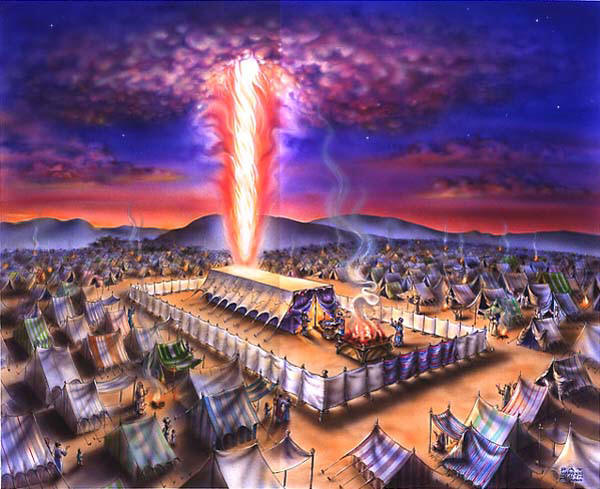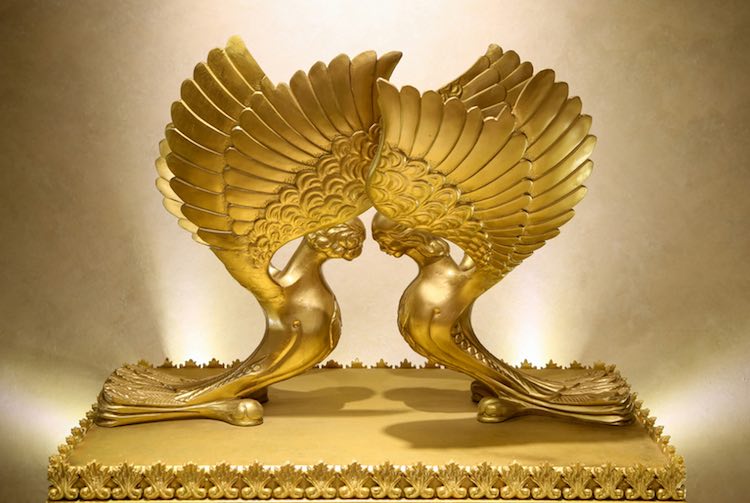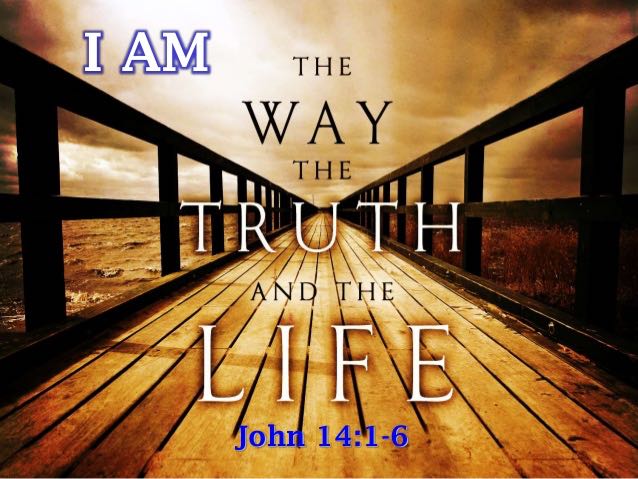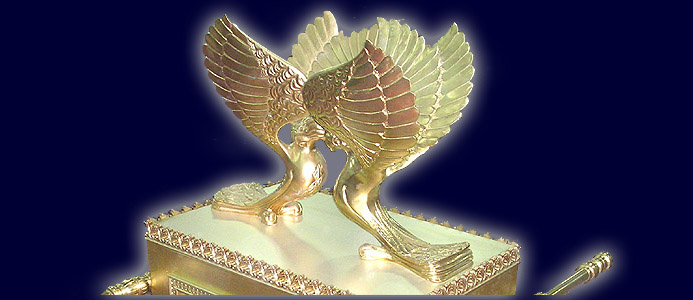In this week’s Torah Portion God instructs Moses to take up a “תרומה” – “terumah,” – “an offering” or “a contribution,” from among the people of the necessary materials (Ex. 25:1-7) for the building of the Tabernacle:
Let them construct a sanctuary for Me, that I may dwell among them. According to all that I am going to show you, as the pattern of the tabernacle and the pattern of all its furniture, just so you shall construct it. – Ex. 25:8-9
It was God’s intention to have a dwelling place in the midst of His people. In order for this to happen, God gave the people a specific plan to follow in order to build this temporary, earthly Tabernacle wherein His very presence would dwell.
The Tabernacle
The majority of the details for the construction of the Tabernacle appear in this week’s reading, Exodus 25:1 – Exodus 27:19. As I was reading these chapters and reviewing the construction of the Tabernacle, it came to my attention that the manifestation of God’s presence would dwell in a certain location in the holy of holies:
The cherubim shall have their wings spread upward, covering the mercy seat with their wings and facing one another; the faces of the cherubim are to be turned toward the mercy seat. You shall put the mercy seat on top of the ark, and in the ark you shall put the testimony which I will give to you. There I will meet with you; and from above the mercy seat, from between the two cherubim which are upon the ark of the testimony, I will speak to you about all that I will give you in commandment for the sons of Israel. – Ex. 25:20-22
The ark of the testimony was the central furnishing in the Tabernacle that came to represent the presence of God with His people. It was at the location above the ark of the testimony that God would meet with and speak to Moses.
The Tabernacle itself was to be the dwelling place of God. The very word “tabernacle” that is used in this context is the Hebrew word “משכן” – “mishkan,” which literally means “dwelling place.” The Tabernacle was the dwelling place of God and within the Tabernacle was the place where God would meet with Moses and where God’s voice would be heard.

The Specific Place of Meeting
The LORD gave great detail in explaining to Moses how the Tabernacle was to be constructed and exactly where the LORD Himself would meet with Moses to speak with him there:
There I will meet with you; and from above the mercy seat, from between the two cherubim which are upon the ark of the testimony, I will speak to you about all that I will give you in commandment for the sons of Israel. – (Ex. 25:22)
As the LORD had clearly instructed Moses regarding how the ark of the testimony (covenant) was to be constructed, the LORD specified where he would meet with him; in the space above the mercy seat and between the two cherubim.
This meeting place was not arbitrary, but rather it had significant meaning both in its location within the Tabernacle and even within the Hebrew wording itself. When God said to Moses “There I will meet with you” (Ex. 25:22), we read the Hebrew phrase “ונועדתי לך שם” – “ve’no’a’de’ti le’cha sham.” The English translation is quite clear and accurate here but the word “to meet” comes from the Hebrew root word “יעד” – “ya’ad” which literally means “to fix by agreement or appointment.”
It is from this same Hebrew root “יעד” – “ya’ad” that we get the Hebrew word “מועד” – “mo’ed” which is used in reference to the “feasts” or “מועדי יהוה” – “Mo’ed’ei Adonai” – “the appointed times of the LORD” (Lev. 23:1-2). Therefore, we see clearly that when the LORD designated this specific location to meet with and speak to Moses in the Tabernacle, it was to be an appointed place for God to communicate His Word to His people.
The exact location of God’s meeting place with Moses was “…above the mercy seat, from between the two cherubim…” (Ex. 25:22). There was this space between the mercy seat and the two cherubim that God had chosen to reveal His glory. The phrase “mercy seat” in Hebrew is the word “הכפורת” – “ha’kaporet” which is also called “the place of atonement” because it comes from the word for “atonement” – “kapar” – “כפר.” To read more about the “mercy seat,” I recommend the following article: The Place of Atonement
The Cherubim
A unique aspect to the place where God would meet with Moses was the two cherubim which were connected to the mercy seat. It seems from the description found in the Scriptures that the Cherubim and the mercy seat were literally one unit:
You shall make a mercy seat of pure gold, two and a half cubits long and one and a half cubits wide. You shall make two cherubim of gold, make them of hammered work at the two ends of the mercy seat. Make one cherub at one end and one cherub at the other end; you shall make the cherubim of one piece with the mercy seat at its two ends. – Ex. 25:17-19
From this English translation it would seem clear that the two cherubim were clearly part of the mercy seat, however, the Hebrew doesn’t literally say “one piece” as in the above translation but only that the cherubim were to be constructed “מן הכפורת” – “min ha’ka’poret,” – “from the mercy seat.” It can be assumed that they were one piece from this statement that they were one piece.

Later in the book of Exodus when Bezalel actually constructed the Tabernacle with all of its utensils, we read the following description of the mercy seat and cherubim:
He made two cherubim of gold; he made them of hammered work at the two ends of the mercy seat; one cherub at the one end and one cherub at the other end; he made the cherubim of one piece with the mercy seat at the two ends. – Ex. 37:7-8
Here again, the Hebrew doesn’t literally say “one piece,” however, it does describe the cherubim as being constructed out of the mercy seat as one unit. Since the cherubim and mercy seat are explained in this way it appears that they are one piece.
Why are cherubim part of the Tabernacle?
As I was studying the construction of the Tabernacle, with specific emphasis on the meeting place of God “…above the mercy seat, from between the two cherubim…” (Ex. 25:22), I couldn’t help but wonder what is the significance of the cherubim. Since the mercy seat is also the place of atonement, it makes sense that God would choose the place connected to atonement, however, what is the significance of the cherubim?
There were two cherubim that were connected to the mercy seat, one at either end. These two cherubim were situated above the mercy seat and the space between the two cherubim was the location of the dwelling of the LORD. Beyond this, there were also cherubim embroidered on the veil which separated the holy place from the holy of holies: “You shall make a veil of blue and purple and scarlet material and fine twisted linen; it shall be made with cherubim, the work of a skillful workman.” (Ex. 26:31) Cherubim held a significant presence in the Tabernacle. Why were cherubim so visibly present in the place where God’s presence dwelt?
Guardians of the Tree of Life
Cherubim are mysterious beings that are characterized as having wings and play a unique role in God’s service. Before the mention of cherubim in Exodus 25 there is only one mention of cherubim the Torah:
So He drove the man out; and at the east of the garden of Eden He stationed the cherubim and the flaming sword which turned every direction to guard the way to the tree of life. – Gen. 3:24
In the very beginning, after the fall of Adam and Eve, we read how God placed cherubim east of the garden of Eden to guard the way to the tree of life.
Guardians of God’s Presence
In the garden of Eden, Adam and Eve enjoyed unhindered fellowship with the living God. In the garden of Eden they could also eat of the tree of life and live forever. These two privileges came to an end when they sinned and the cherubim were stationed at the entrance to the garden of Eden where man and God enjoyed sweet fellowship. The way into God’s unhindered presence and the path to take of the fruit of eternal life had been blocked.
It appears that just as the cherubim were utilized as guardians to the presence of God and to the path to the tree of life, cherubim were also being used as symbols of God’s presence in the Tabernacle. God would dwell in the midst of His people Israel through the vehicle of the Tabernacle, however, the way was still being guarded by cherubim. Access to God was still limited and the images of the cherubim were a continual reminder that the way to God is guarded.

Vehicles of God’s Glory
In the book of Ezekiel we see another aspect of the responsibility of cherubim in guarding, protecting, and transporting the glory of God in a vision of Ezekiel:
Then the glory of the LORD departed from the threshold of the temple and stood over the cherubim. When the cherubim departed, they lifted their wings and rose up from the earth in my sight with the wheels beside them; and they stood still at the entrance of the east gate of the LORD’s house, and the glory of the God of Israel hovered over them. – Ezekiel 10:18-19
When the glory of the LORD departed from the Temple in the vision of Ezekiel, the cherubim accompanied the glory of the LORD.
Access to God’s presence has been guarded by cherubim since the fall of man in the garden of Eden and continued as God made a dwelling among men in the Tabernacle and the Temple. The cherubim had a very prominent place in the Jewish mind when considering drawing near to the presence of God. We see evidence of this in the prayer of Hezekiah as recorded by the prophet Isaiah:
Hezekiah prayed to the LORD saying, “O LORD of hosts, the God of Israel, who is enthroned above the cherubim, You are the God, You alone, of all the kingdoms of the earth. You have made heaven and earth. – Isaiah 37:15-16
The cherubim were etched in the minds of the Jewish people as they prayed to the LORD of heaven and earth. There was access to God in prayer under the Old Covenant but there was also a continual reminder that the path to God was guarded by cherubim.
From Glory to Glory
Although cherubim are mentioned throughout the Old Testament, we only see one reference to cherubim in the New Testament and this is in connection to the Tabernacle: “…and above it were the cherubim of glory overshadowing the mercy seat; but of these things we cannot now speak in detail.” (Hebrews 9:5) Cherubim are never directly mentioned in the New Testament outside of this one verse in the letter to the Hebrews.
The letter to the Hebrews focuses mainly on the New Covenant which was instituted by the sacrifice of the Messiah and continues under the priesthood of the Messiah. As a result of this New Covenant there is no longer any need for the cherubim to stand guard over the glory and presence of the LORD:
Therefore, brethren, since we have confidence to enter the holy place by the blood of Yeshua, by a new and living way which He inaugurated for us through the veil, that is, His flesh, and since we have a great priest over the house of God, let us draw near with a sincere heart in full assurance of faith, having our hearts sprinkled clean from an evil conscience and our bodies washed with pure water. – Hebrews 10:19-22
Yeshua came to this earth to create a new path to God that would make the former path obsolete. The glory and presence of God, which were hidden in the Tabernacle and guarded by the cherubim, were now made available to each one through the all-sufficient sacrifice of the Messiah.

The Way to God
For approximately four-thousand years cherubim were identified with accessing God’s presence. Cherubim were there at the beginning as they guarded the path to the tree of life and they continued to guard the presence of God in the Tabernacle and the Temple. It was only through the coming of the Messiah that the Temple veil was torn in two (Matt. 27:51) and the cherubim were relieved of their duty.
Yeshua taught His disciples that the only way to the Father in heaven was through knowing Him. Yeshua’s disciples were good Jewish men and they understood that the cherubim guarded the way to God through the Temple system which God gave them through Moses. Yeshua told His disciples that a new way was now available which superseded the cherubim:
“…And you know the way where I am going.” Thomas said to Him, “Lord, we do not know where You are going, how do we know the way?” Yeshua said to him, “I am the way, and the truth, and the life; no one comes to the Father but through Me.” – John 14:4-6
These famous words of Yeshua remind us that the way that had been formerly blocked and guarded for thousands of years was now made open again through His very being. Yeshua Himself is the way to the Father in heaven and the path is no longer obstructed by the cherubim. Yeshua is the Way!
Shabbat Shalom – We welcome your comments below!
If you enjoyed reading this article, share it today with friends! We also invite you to sign up for our weekly Torah Portion commentary on the sidebar to the right.
Help keep our weekly commentaries free and available to all. Click here to donate today:
Torah Portion: Ex. 25:1 – Ex. 27:19
Haftara: 1 Kings 5:26 – 1 Kings 6:13
Return to Torah Portion Homepage
Copyright Jewels of Judaism. All rights reserved 2017



Thank you for exposing this hidden reality.
This was a very interesting article Daniel…it brought up some questions in my mind about cherubim. It seems very interesting that those creating the mercy seat and the veil actually knew what cherubim looked like…even though God did not specifically describe them as He had described in detail so many other things. It makes me wonder if the description of cherubim had been passed down from generation to generation from Adam or if it was a normal part of everyday life to see cherubim and other angelic beings during that time in history?
Also as I read your take on the cherubim not being needed anymore because the way to the Father has been opened through Yeshua I had to wonder if we are in Yeshua as John and Ephesians claims does that mean that we could have taken over the job of the cherubim as we carry and guard the presence of God inside us? There have been times in worship that I have felt the presence of God so strong and have seen visions of what appears to be the ark of the covenant and the mercy seat. I wonder as we are now priests and kings in Yeshua and we bring an offering of praise and sacrifice before the throne of God if in reality we are positioning ourselves up on the mercy seat and looking into the presence of God getting full of His glory then manifesting it back out to the world so they can see and experience His glory…”Lift up your heads oh you gates…that the King of glory may come in…” As the cherubim were gates to the glory of God is that what David saw when he wrote that Psalm? Are we now the gates to the presence of God through Yeshua…?
Hi Suzanne,
Thanks for your comments. Lots of good questions as well.
Regarding the design of the cherubim, it could have been that a description was passed down from generation to generation or it could just be that God gave Betzalel the revelation he needed to design them (Ex. 35:30-35). Regarding the other questions, we just don’t know. I believe that Cherubim still function in the heavenly realm, and possibly earthly realm as well, for His glory. We are simply not privy to this information right now. Since the veil of the Temple was torn in two and the way has been opened for all to come into the presence of God through the Messiah, I would say that protocol has changed.
Please feel free to share more if you have other insights.
Blessings,
Daniel